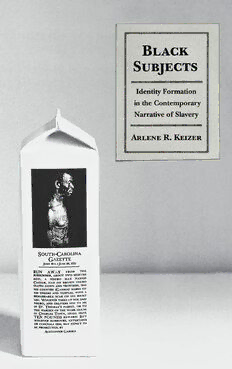
Black Subjects: Identity Formation in the Contemporary Narrative of Slavery PDF
Preview Black Subjects: Identity Formation in the Contemporary Narrative of Slavery
BLACK SUBJECTS BLACK SUBJECTS Identity Formation in the Contemporary Narrative of Slavery ARLENE R. KEIZER Cornell University Press Ithaca and London Copyright© 2004 by Cornell University Portions of Black Subjects have been previously published as follows: An earlier version of chapter I appeared in African American Re view 33.I:I05-23. A portion of chapter 5 appeared in American Literature 72.2:387-4I6. Segments of the conclusion appeared in Michigan Quarterly Reivew 40.2431-36. All rights reserved. Except for brief quotations in a review, this book, or parts thereof, must not be reproduced in any form with out permission in writing from the publisher. For information, ad dress Cornell University Press, Sage House, 5 I 2 East State Street, Ithaca, New York I485o. First published 2004 by Cornell Universitv Press First printing, Cornell Paperbacks, 2004 Printed in the United States of America Design by Scott Levine Library of Congress Cataloging-in-Publication Data Keizer, Arlene R. Black subjects : identity formation in the contemporary narra tive of slavery / Arlene R. Keizer. p.cm. Includes bibliographical references and index. ISBN o-8oi4-4095-5 (cloth: alk. paper)-ISBN o-8o14-89o4-o (pbk. : alk. paper) 1. American fiction-2oth century-History and criticism. 2. Slavery in literature. 3· Caribbean literature (English)-His tory and criticism. 4- Walcott, Derek. Dream on Monkey Moun tain. 5· Identity (Psychology) in literature. 6. African Americans in literature. 7· Slave trade in literature. H. Blacks in literature. I. Title. PS374.s58K{5 2oo4 8I3' .5093552-dc22 200400II33 Cornell University Press strives to use environmentally responsible suppliers and materials to the fullest extent possible in the publish ing of its books. Such materials include vegetable-based, low-VOC inks and acid-free papers that are recycled, totally chlorine-free, or partly composed ofnonwood fibers. For further information, visit our website at www.cornellpress.cornell.edu. Cloth printing IO 9 8 7 6 54 3 2 I Paperback printing IO 9 H 7 6 54 3 2 I This book is dedicated to my beloved mother Annette R. Keizer and to my beloved mentor and friend Barbara T. Christian ( 1943-2000) Oh, we have paid for our children's place in the world again, and again ... Dessa Rose, SHERLEY ANNE WILLIAMS So it is important to undo whatever words obscure the fact that slave law was at least as fragmenting and fragmented as the bourgeois world view-and in a way that has persisted to this day, cutting across all ideological boundaries. As "pure will" signifies the whole bour geois personality in the latter, so wisdom, control, and aesthetic beauty signify the whole white personality in the former. The slave master and the burgermeister are not so very different, when ex pressed in those terms. The reconciling difference is that in slave law the emphasis is really on the inverse rationale: that irrationality, lack of control, and ugliness signify the whole slave personality. ... In my search for roots I must assume, not just as history but as an ongoing psychological force, that irrationality, lack of control, and ugliness signify not just the whole slave personality, not just the whole black personality, but me ... To look is ... to make myself vulnerable; yet not to look is to neu tralize the part of myself that is vulnerable. I look in order to see, and so I must look. Without that directness of vision, I am afraid I shall will my own blindness, disinherit my own creativity, and sterilize my own perspective of its embattled, passionate insight. PATRICIA]. WILLIAMS, The Alchemy of Race and Rights The themes, then, that I wish to pursue here are centered on there lation between the writing of history as prediction and as retrospec tion. The history that will be is, after all, as much how we recount what happened as how we project a future; the history that will be is, inevitably, a history of the present, that divided site that must look both ways at once. JoNATHAN GOLDBERG, "The History That Will Be" CONTENTS Acknowledgments zx Introduction. "The Middle Passage Never Guessed Its End": New World Slavery in Contemporary Literature I 1. Beloved: Ideologies in Conflict, Improvised Subjects 2 I 2. Being, Race, and Gender: Black Masculinity and Western Philosophy in Charles johnson's Works on Slavery 48 3· The Chosen Place, The Timeless People: Late Capitalism in the Black Atlantic 77 4· Performance, Identity, and "Mulatto Aesthetics" in Derek Walcott's Dream on Monkey Mountain 99 5· The Geography of the Apocalypse: Incest, Mythology, and the Fall of Washington City in Carolivia Herron's Thereafter johnnie I 2 5 Conclusion. "One Lives by Memory, Not by Truth" I64 Works Cited I 8 9 Index I99
